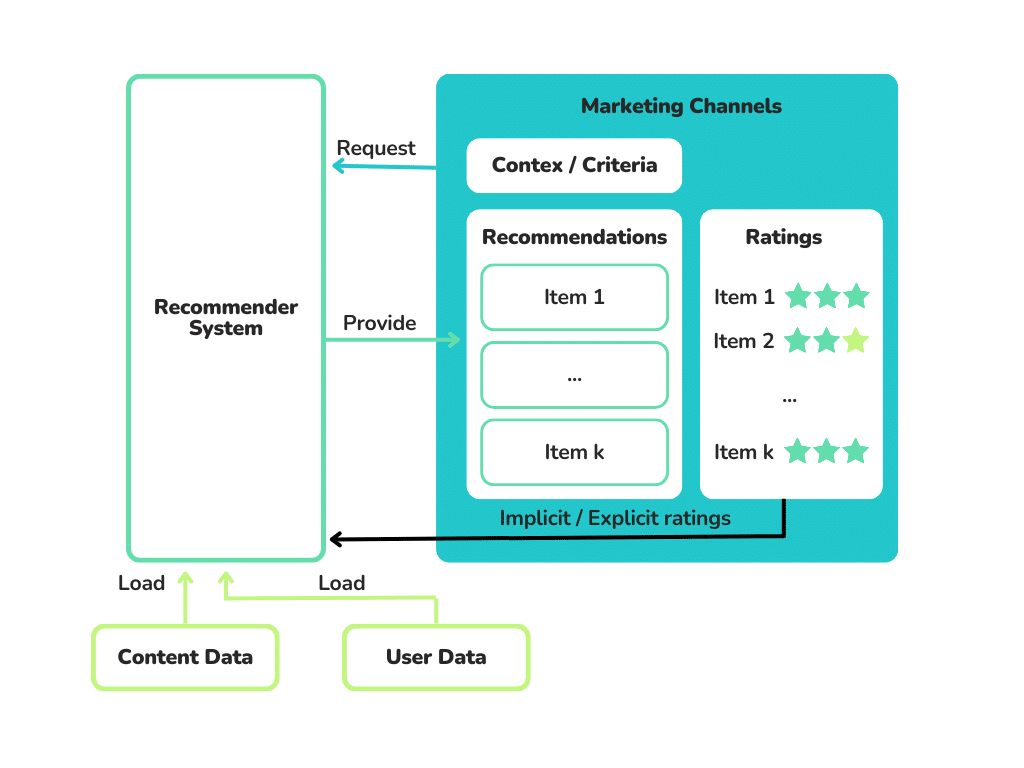How a Recommendation Engine Can Boost Your Sales
Do you like movies that Netflix recommends to you based on your interests? Not always? Is this a bug or feature?
About 75% of Netflix’s content is discovered through its recommendation engine. It analyzes the features of the movies you have watched, and based on the recommended system, it will suggest similar movies next time.
In today’s fast-paced digital world, consumers are overwhelmed with information, so businesses need help to catch their target audience’s attention and keep them engaged. To address this challenge, numerous companies, such as Google, Facebook, and Amazon, started to use an AI-powered recommendation engine that provides personalized recommendations to customers based on their past behaviors and preferences.
In this article, we will explore the following:
- what a recommender system is;
- how it works;
- what types of recommendation systems exist;
- benefits of using a recommendation engine to boost your sales;
- five helpful tips for increasing your sales.
What is a recommender system?
A recommender system is an unsupervised machine-learning algorithm that provides personalized recommendations to users based on their past behavior, preferences, and characteristics.
It is an effective technique in terms of business, as its primary goal is to help users discover relevant content or products they are likely to be interested in and increase user engagement, satisfaction, and loyalty.
How does it work?

Here is a general overview of how a recommendation system works in detail:
Data Collection: The first part of a recommendation system is to gather user data, such as purchase history, search history, ratings, and reviews.
Data Preprocessing: The collected data is then preprocessed to remove any irrelevant or incomplete information and to transform the data into a standardized format.
Data Representation: The preprocessed data is then represented in a way that can be used by the recommendation algorithm, such as a matrix of user-item interactions or a graph of user similarities.
Algorithm Selection: There are several types of recommendation algorithms, including content-based filtering, collaborative filtering, and hybrid methods. The algorithm chosen will depend on the recommendation system’s specific requirements and the data’s nature.
Training: Once the algorithm is selected, it is trained on the preprocessed data to learn patterns and relationships between users and items.
Recommendation Generation: After training, the recommendation system can generate recommendations for new items based on the learned patterns and relationships. These recommendations can be personalized for individual users and can be based on factors such as similarity to other users, item popularity, and user preferences.
Evaluation: The recommendation system is then evaluated using metrics such as precision, recall, and mean average precision to assess its performance and refine the algorithm if necessary.
Deployment: Finally, the recommendation system is deployed in the production environment, where it can generate real-time recommendations for users based on their interactions with the system.
Want to discuss a recommendation system for your business?
What are the types of recommendations?
Recommender systems are commonly used in e-commerce, media, social networks, and other online platforms to suggest products, movies, music, books, news, or friends. There are different types of recommender systems, including:
Collaborative filtering
The collaborative filtering approach is based on the idea that users with similar preferences are likely to have similar choices in the future.
For instance, we’ve noted Netflix above. To help its users discover content they are likely to enjoy, Netflix uses the collaborative filtering approach that analyzes users’ viewing history, ratings, and interactions with the platform to make personalized recommendations.
Content-based filtering
The content-based filtering approach suggests items similar to the ones a user has liked before based on their attributes or features.
If you are a music fan, you might have guessed that one famous company uses content-based filtering. Yes, this is Spotify.
Its recommendation system uses a content-based filtering approach that analyzes the audio features of the songs a user has listened to and liked, such as tempo, key, genre, and instrumentation, to make personalized recommendations. For example, if a user frequently listens to and likes acoustic songs with female vocals, Spotify’s recommendation engine might suggest other songs with similar acoustic and vocal qualities.
Hybrid recommendation systems
Some recommender systems use a hybrid approach combining collaborative and content-based filtering to generate recommendations. The system uses user behavior and item attributes in these systems to provide more accurate and diverse offers.
Amazon is another famous company that uses a hybrid recommendation system. Amazon attributes 35% of its revenue to its recommendation engine. Their system considers not only the customer’s purchase history and ratings but also their search queries, browsing history, and even the items they have added to their shopping cart but have yet to purchase.
By analyzing multiple data sources, Amazon’s hybrid recommendation system can provide highly personalized and relevant recommendations to their customers, contributing to the company’s success as one of the world’s largest online retailers.
What advantages do recommendation systems offer for increasing your sales?
The benefits of recommendation systems for sales can result in increased revenue, customer satisfaction, loyalty, and decreased costs, making them valuable tools for businesses. There are several benefits that recommendation systems can offer to boost sales:
Personalization
A recommendation system can provide personalized recommendations to customers based on their browsing and purchase history. This personalized approach can lead to more relevant product suggestions, resulting in a higher likelihood of the customer making a purchase.
Cross-selling and upselling
Recommendation systems can suggest complementary or higher-priced items to customers based on their current purchases, encouraging cross-selling and upselling. For example, if a customer buys a camera, a recommendation system can suggest accessories like lenses, tripods, or memory cards.
Increased customer satisfaction
Recommendation systems provide customers with a better shopping experience by making finding the products they want easier.
Data-driven insights
A recommendation system can provide valuable insights into customer behavior and preferences, which can be used to inform marketing and sales strategies. This data can help you identify trends and patterns in customer behavior and opportunities for new products or services.
Enhanced interaction with customers
By providing relevant and personalized recommendations, recommendation systems can help increase customer loyalty and encourage repeat purchases.
5 advice for increasing your sales
Ideally, the recommendation engine should aim to provide value to customers while generating revenue for the business. However, in practice, people use recommendation engines to recommend products without considering whether they truly benefit the customer.
It is crucial to differentiate yourself from the crowd and avoid simply following industry norms. So, focus on developing unique and innovative practices to improve customer experience and increase revenue growth.
To gain a more comprehensive understanding, here are 5 helpful tips for increasing your sales with the help of recommendation engines.
#1 Personalize recommendations
Use customer data and behavior to personalize product recommendations, providing suggestions tailored to each individual’s preferences and interests. It can increase engagement and higher conversion rates.
#2 Offer complementary products
Recommend products that complement items that the customer has already expressed interest in or purchased. It boosts the overall value of the customer’s shopping experience and encourages them to make additional purchases.
#3 Use social proof
Incorporate social proof into your recommendations by highlighting products that have been popular with other customers or have received positive reviews. It builds trust with customers and encourages them to purchase.
#4 Leverage user-generated content
Use user-generated content like photos or reviews to inform and enhance recommendations. It can add a personal touch to the shopping experience and help customers feel more connected to the products.
#5 Continuously test and optimize
Continuously test and optimize your recommendation algorithms to improve their effectiveness over time. It helps ensure that your recommendations are relevant, accurate, and effective in driving sales.



